by Matt Lollar | Jun 21, 2018
Are you interested in growing squash in your garden? Do you know the difference between summer squash and winter squash? Check out this very informative instructional video on growing squash in your home garden by Walton County Agriculture Agent Evan Anderson.
[youtube https://www.youtube.com/watch?v=hlbJfV-0FuU&w=560&h=315]
by Ray Bodrey | Jun 7, 2018
Camellias are a Panhandle favorite, as the flowers can highlight a landscape with bright, vibrant colors in fall and winter. However, spring time can bring about these colors in a negative way, in the form of leaf gall.
The camellia is native to Asia and brought to America in the late 1700’s. These plants have proven to be a dependable addition to the southern landscape with minimal care. When camellias are correctly planted and cared for, minimal disease problems arise. However, camellias can contract leaf spot, dieback, root rot and bud and leaf gall.
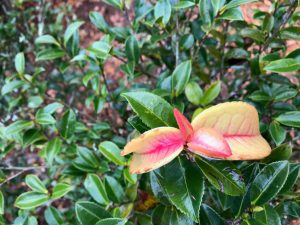
Camellia Gall Credit: Patty Dunlap, Gulf County Master Gardener.
Leaf and bud galls are caused by the fungus Exobasidium vaccinia. The gall appears as thickened, waxy and enlarged leaves or buds during the cool spring months. One or several leaves on a single shoot may be affected. Once you’ve found infected leaves, no chemical control will be effective. Actually, no fungicide has been found very effective in combatting this condition. However, control can be accomplished in the home garden by simply pinching off and destroying infected leaves. Disease activity usually stops with warmer weather. A best management practice to curb infection is to reduce overhead watering during cool, wet weather periods of spring. Great news, this condition does not cause any long-term issues with the plant.
For more information regarding fungal issues in landscape plants, contact your local county extension office.
Fun camellia fact: The young leaves of the species, Camellia sinensis, are processed for tea, one of the world’s most popular drinks. Please see UF/IFAS EDIS publication, “Tea Growing in the Florida Landscape” by Jonathan H. Crane and Carlos F. Balerdi: http://edis.ifas.ufl.edu/pdffiles/HS/HS30800.pdf
Supporting information for this article can be found in the UF/IFAS EDIS publication, “Camellias at a Glance” by Sydney Park Brown: http://edis.ifas.ufl.edu/pdffiles/EP/EP00200.pdf
UF/IFAS Extension is an Equal Opportunity Institution.
by Matt Lollar | Jun 4, 2018
Normally we think of rust as something that deteriorates metal, but a number of different fungal rusts can affect plants in the garden. Rust disease can affect corn plants, cedar trees, and even blueberry bushes. Just like the broad range of plant species that can be plagued by rust, there are a number of species of rust fungal spores floating around and ready to infest your garden. This article will focus on leaf rust of blueberry.
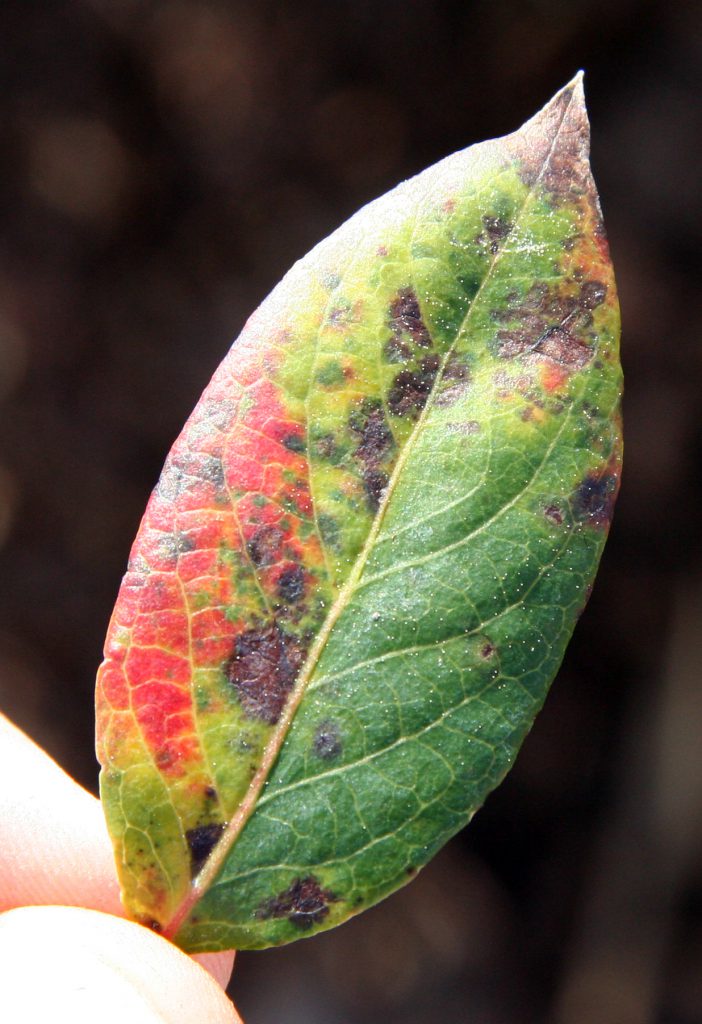
Blueberry leaf rust on the top of a leaf. Photo Credit: Philip Harmon, University of Florida/IFAS Extension.
Leaf rust of blueberry in Florida is caused by the fungus Pucciniastrum vaccinii. Although the common name of the disease is “leaf rust”, the disease can also infect the stems and fruit of blueberry plants. The disease causes small, round spots visible on the tops of leaves. Spots will multiply and the leaves will eventually yellow and fall off. Young stems and green fruit can also become infected as the disease progresses. Bright orange lesions will form on stems and fruit as the thousands of microscopic spores conjoin. The clusters of spores are easily wiped or washed off of plant material. When spores dry out, they become airborne and can be transferred to nearby plants.

Blueberry leaf rust on fruit. Photo Credit: Philip Harmon, University of Florida/IFAS Extension
The rust fungus thrives in hot, humid, wet conditions. A number of cultural practices can be adopted to reduce disease progression and survival.
-
Irrigation
Disease persistence can be reduced by limiting the amount of water that contacts the plant leaves. Water the base of plants or install drip irrigation for your bushes rather than watering from overhead. If overhead irrigation is the only option, then water plants in the morning rather than in the evening. This allows the leaves to dry out over the course of the day.
-
Pruning
Removal of approximately 25% of the oldest canes in late winter before spring growth begins will stimulate the production of new canes and should result in plants with canes of different ages and will provide a good mix of vigorous branching and fruit production. Moderate summer pruning can also improve yield and shoot growth. When pruning, cut out vigorous shoots that are growing well beyond the desired canopy height and are in the interior portion of the bush. This will promote a more open growth habit and help with air circulation on the remaining plant material. Some vigorous canes developing from the ground and growing on the outside of the bush can be topped to stimulate branching and flower bud formation.
-
Mulch
Pine bark mulch helps with establishment of young plants and helps keep soil pH low in existing plantings. A layer of aged pine bark 3 inches deep extending about 2 feet out from the plants will provide a good growing medium for surface feeder roots. Pine straw can be used if pine bark is unavailable. Mulch also moderates soil temperature, helps keep weeds at bay, and adds organic matter to the soil. Make sure to keep mulch raked back about three inches away from the plant canes to provide good air circulation to the roots.
Hopefully this article has given you some tips to have a good blueberry crop for years to come. For more information on growing blueberries in Florida, please visit the University of Florida/IFAS EDIS Publication: Blueberry Gardener’s Guide.
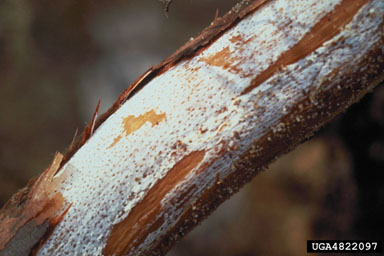
by Matt Lollar | Apr 23, 2018
Recently, an Extension Agent in the Florida Panhandle received a picture of some mushrooms popping up in a client’s garden. These particular mushrooms were in a spot where leftover mushroom compost had been dumped. The compost was previously used to grow oyster mushrooms and the client was hopeful that she had more oyster mushrooms growing in her yard. Unfortunately, the lab results came back stating the mushrooms in question were Armillaria spp.

Armillaria spp. in the garden. Photo Credit: University of Florida/IFAS Extension.
Armillaria spp. cause root rot of trees and shrubs throughout the world. The fungus infects the roots and bases of trees, causing them to rot and eventually die. Some species of Armillaria are primary pathogens that attack and kill plants, but most are opportunistic pathogens that are attracted to unhealthy or stressed plants. Fruiting structures of the fungi can be recognized by the clusters of yellow to brown-colored mushrooms that emerge during wet conditions. However, the mushroom caps sometimes never form and the plant material needs to be inspected more thoroughly to find the disease culprit. Infected plants may have wilted branches, branch dieback, and stunted growth and should be removed and replaced with resistant species.

White mycelial fan under the bark of a root infected with Armillaria tabescens. Photo Credit: Ed Barnard
Management – The best method for controlling Armillaria root rot is with proper plant installation and maintenance. Planting plant material at the proper depth will allow the roots to breathe and reduce the opportunity for the roots to rot. Pruning tools should be sanitized between plant material. Proper irrigation and fertilization will also reduce the risk of plant disease and root rot. Lastly, you can choose to plant a diverse landscape with resistant species.
For more information on Armillaria root rot and a comprehensive list of resistant species, please view the EDIS publication: Armillaria Root Rot
by Daniel J. Leonard | Jan 10, 2018
Are you guilty of “Crape Murder”, the dreaded horticultural sin that involves lopping off your beautiful Crape Myrtles fence post high and creating gnarly looking knuckles? No need to raise hands, you know who you are! Despite the cruelness of this act, all is not lost; there is still time to repent and change your ways! The facts of the matter are, if you have made a habit of lopping the tops off your crapes, you are most definitely not alone, you probably thought you were doing the right thing, and it can be corrected.

Improper pruning of crape myrtles. Photo Courtesy – Beth Bolles.
Crape Myrtle (Lagerstroemia spp.) are one of the most beautiful trees Southerners have in their horticultural arsenal. Unsurpassed in both form and flower, it is easy to see why Crape Myrtle is the most widely planted tree in the Southeastern United States. A mature Crape Myrtle properly grown is a remarkable sight, sinewy limbs reaching high in a vase shape supporting lilac-like flowers that come in a rainbow of colors. These qualities make it even more strange that homeowners and landscape professionals alike insist on butchering them every winter.
Before we move on to corrective procedures, let us examine a few of the reasons that crape murder is committed. First, I think peer pressure has a lot to do with it. When one sees every house on the street and all the business landscapes doing things a certain way, one tends to think that is the correct way. Second, there are folks who believe that pruning their crapes back each year creates a superior flower show. In reality, this practice creates an overabundance of succulent, weak, whippy branches (with admittedly larger flowers) that tend to bend over and break after a summer wind or rainstorm and are more prone to pests and disease. In addition, many homeowners over prune their crapes in this way because they planted a cultivar that grows too large for the site. There are dozens of crape myrtle cultivars sold, be mindful to pick one with a mature size and shape that will fit with the scale of the site!
So, now that we know why crape murder is committed, let’s discuss how to remedy it once the atrocity has already occurred.
- If the improper pruning has not been going on very long (a couple of years or less), it may be possible to correct over time without taking drastic measures. If this is the case, select two or three of the young “whippy” canes that are growing up and out and remove the rest. Ideally, the canes you select will be growing away from the center of the plant and not back into the middle of the plant or straight up to facilitate proper branch spacing as the tree continues to grow. The canes you select now will become primary branches in the years to come, so plan and prune carefully. Repeat for each main trunk that has been “murdered”. You will have to keep watch on the cut areas, as they will attempt to regrow as suckers after pruning; simply remove these juvenile shoots until they stop emerging.
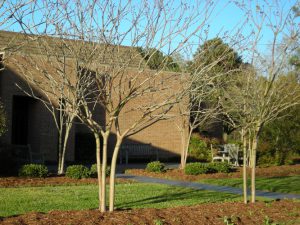
Properly pruned crape myrtle. Photo courtesy – North Carolina Cooperative Extension
- If the murder has been going on for more than a year or two, it likely cannot be corrected without a major rejuvenation of the plant. Though it will likely be painful for you emotionally and seemingly run counterintuitive to your instincts, the best method to rejuvenate a disfigured crape is to break out the chainsaw and cut the plant back to the ground! This forces the plant to do one of two things; either grow an outrageous number of new shoots or die. In most cases however, the crape myrtle’s tough constitution permits it to regrow from the stump. The first growing season after performing this procedure, allow the shoots that sprout to grow and do not prune. The winter following the first growing season, remove all except three to five strong, well-spaced shoots and allow these to become the new plant’s main trunks. In all succeeding years, only prune to remove dead wood, crossing branches and branches growing toward the center of the plant.
If you have been guilty of crape murder, it is not too late to change your ways! Follow these steps, get out and enjoy the cool weather, and get to correcting your mistakes while the plants are still dormant! As always, if you have any questions about the topic of this article or any other horticultural topics, please contact your local Extension office and happy gardening!

by Mark Tancig | Sep 18, 2017
Hopefully, by this time of year, most north Florida gardeners have harvested their figs and are enjoying fig preserves or fig bars. But if you’ve noticed your fig leaves dropping a little early, it may be a sign of the fungal disease Fig Rust (Cerotelium fici).
Figs are a great fruit tree for the north Florida home garden. Not only do they provide a tasty reward (if you can keep the birds and squirrels away), but they are fairly easy to maintain and are bothered by relatively few pests and diseases. One of the few diseases that can be common, however, is fig rust, especially when conditions are favorable. In the case of fig rust, a fungus, warm humid weather is what it likes and well, we have plenty of that.
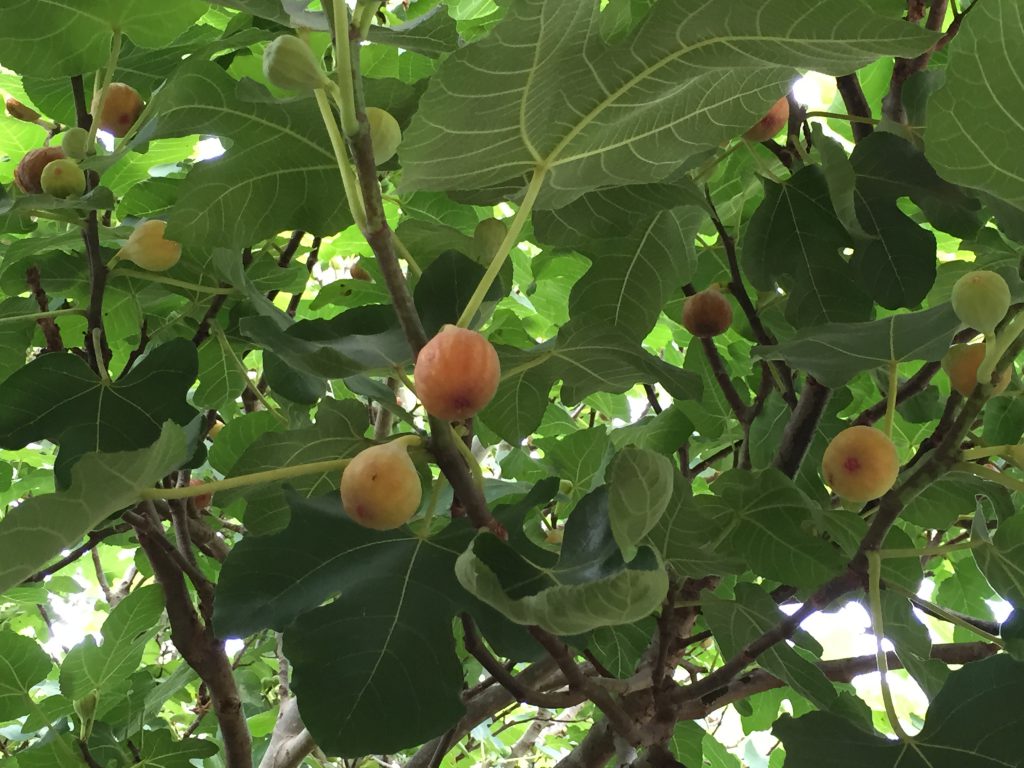
Figs are a great fruit tree for North Florida. Credit: Mary Derrick, UF/IFAS.
The first signs of the fig rust disease are small yellow to yellow-green spots/lesions on the upper surface of the leaf that turn a reddish-brown color as they get larger. A heavy infestation causes the leaves to turn yellow and drop early. While fig rust does not injure the fruit, repeat occurrences of premature leaf drop can adversely affect the overall health of the tree, resulting in yield loss. Another concern is that if the leaves drop too early, the tree will flush out with new growth heading into winter. This new growth can be injured by early freezes and cause a loss of fruit the following season.

Fig rust on leaves. Credit: UF/IFAS.
What can you do to prevent and/or cure fig rust? Unfortunately, once you see the yellowish-green/reddish-brown spots on the leaves, it’s too late to provide any control. As always, proper cultural practices can help. Pruning the tree to provide adequate airflow keeps the leaves as dry as possible during our humid summers. Remember to prune fig trees in Florida after fruit harvest, not in the dormant season, since fruit is borne on previous year’s growth. Another cultural control to prevent fig rust is to rake diseased leaves out from under the tree. The fungal spores in the fallen leaf litter pass the disease on to next year’s leaves. Other cultural controls include providing adequate moisture and placing a healthy dose of mulch around the tree. Figs require minimal fertilizer. Using a general complete fertilizer with micronutrients (such as a 10-10-10), young trees should receive 1 cup (1/2 pound) and mature trees 4-8 cups (2-4 pounds) per year.
There are currently no chemical controls approved for fig rust in Florida. The classic Bordeaux mix is recommended by various authors to be used as a preventative fungicide during the dormant season, before the lesions appear on the leaves. The Bordeaux mixture is a mix of copper sulfate, lime, and water in a 1:1:10 ratio and is considered an organic pesticide. This mix has been used since the late 19th century and was discovered by accident after botanists and farmers realized that grapevines sprayed with the mix to deter theft had less fungal problems. As with any pesticide, be cautious when using. Overuse of copper-based fungicides can cause copper to build up in soils, leading to potential issues to plant and human health.
While figs are generally worry free for our area, fig rust is one disease to be on the lookout for. Good gardening practices can reduce the occurrence of this disease and ensure a bountiful harvest. For questions on growing figs or about the fig rust disease, visit the UF/IFAS EDIS website – edis.ifas.ufl.edu – or contact your local Extension office.










